Tarantulas come in all sorts of colours from regular brown, to striking electric blue, green, pink or even multicoloured. Here we have listed the top 10 (in our opinion) that are the most beautiful to look at and would make an envious addition to any hobbyists collection.
Orange Baboon Tarantula (OBT) (Pterinochilus murinus)
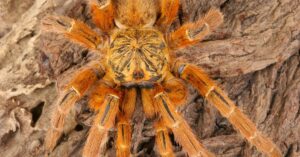
Coming in at number 10 is the good old OBT, also known as the “orange bitey thing”, the OBT originates from the African continent. They are an Old World tarantula, are known to be aggressive and have a very painful, although not serious, bite.
OBTs have a striking orange colouration all over their body, though the legs typically have brightly coloured rings.
The carapace has a star-shaped pattern, with a fishbone pattern present on the abdomen.
They are very popular amongst experienced hobbyists (they are definitely not a beginner tarantula) for their striking appearance and confrontational behaviour.
Mexican Jade Fuego (Aphonopelma mooreae)
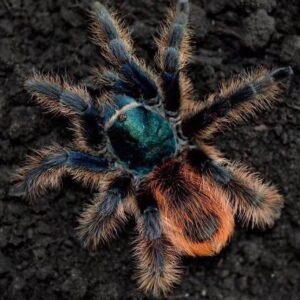
The Mexican Jade Fuego is named after Barbara Moore, who is the President of the American Arachnological Society. This tarantula’s legs are a metallic blue, getting to be almost black in some areas, covered in long slender reddish hairs.
The carapace is a metallic blueish-green colour, and the abdomen is black with long reddish hairs. This is one of the hairer tarantulas.
This is quite a new tarantula amongst the hobby keeping community and whilst as an adult it is indeed extremely striking, most owners only have slings or juveniles at present so are unable to show off its remarkable beauty.
They are also extremely expensive coming in at anywhere between $1,000 – $3,000!
Females can live about 20 years, while males only reach 8 years.
Amazon Blue Bloom (Xenesthis intermedia)
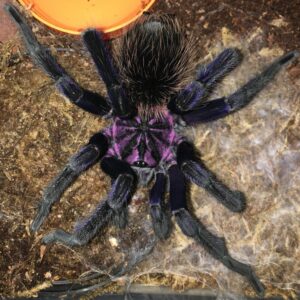
Whilst all of the Xenesthis genus are beautiful, our favourite is the The Amazon Blue Bloom, also known as the Amazon Blue Bloom Birdeater and the Venezuelan Blue Bloom. It originates from Venezuela.
As a New World tarantula, they are more prone to kick hairs that bite. As they mature, they have striking black legs with a purple and blue colouration on the uppers. The carapace is purple with a black star like marking and the abdomen is black covered in light coloured hairs.
They are able to grow to about 8 inches.
Green Bottle Blue Tarantula (Chromatopelma cyaneopubescens)
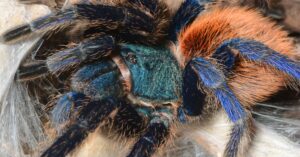
These tarantulas originate from South America, specifically Venezuela.
They are a multi-coloured spider having a green carapace, metallic blue legs and bright orange abdomen. Spiderlings are also very attractive and have a gold carapace, pink legs and tiger stripes on the abdomen.
These are another sought after tarantula amongst hobbyists, due to their temperament, wonderful colouration and are very easy to keep.
Antillies pinktoe (Caribena versicolor)
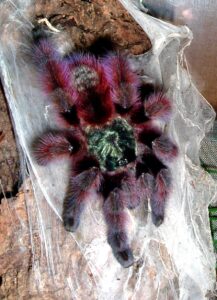
Spiderlings of C. versicolor are bright blue, with a black tree trunk pattern on the abdomen.
As they grow, they gradually lose their blue coloration; the carapace turns green, the abdomen red, and the legs turn green with pink tarsi and a covering of purple hairs.
Males are usually slightly more brightly coloured than females.
They are an arboreal tarantula, usually reaching sizes of 2.5 inches. As they are a New World tarantula, they have urticating hairs which they prefer to use as a defence mechanism rather than biting. This makes them a great beginner tarantula.
Females can live for up to 12 years whereas males only live 2-3 years.
Columbian Purple Bloom (Pamphobeteus insignis)
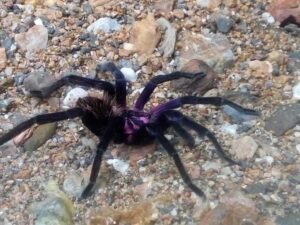
Originating from South America, this is one of the rarest and most demanded tarantulas in the hobby.
Females are a rich, reddish-brown whereas mature males have a beautiful deep “purple” bloom coloration not only in their femurs, but on the carapace as well.
They can grow up to 7.5 inches with males maturing in 1.5 years and females in 2.5 years.
Polychromatic Earth Tiger (Haploclastua Devamatha)
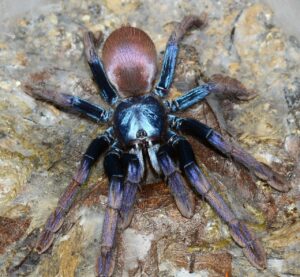
These extraordinary looking tarantulas are found in the Western Ghats region of India near Kerala. They are extremely colourful, one of its common names is the “LSD Tarantula” due to the reflective and metallic sheen of colour that this species displays.
As with many colourful species, this one starts out as a dull brown looking spiderling and grows quickly to display metallic and reflective hues of blue, turquoise and everything in between over its femurs and carapace, with a pink/grape metallic looking abdomen.
Its colours are made to look almost prismatic as light moves over the metallic shine of its body.
They are typical of an Old World in that they can be defensive and aggressive.
Males live 2-4 years and females live up to 12 years.
Golden Blue Leg Baboon (Harpactira pulchripes)
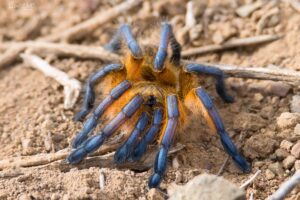
This Old World baboon tarantula comes from South Africa and reaches sizes of 5 inches.
Unlike the OBT, the h. pulchripes is a more relaxed baboon tarantula and spends a lot of time out on display.
Similar to the OBT, this is a predominantly orange baboon although it has striking blue legs. The carapace has the same star shape on the abdomen.
Females can live for 12 years and males live for 2 to 3 years.
Peacock tarantula, also known as the Gooty Sapphire Ornamental (Poecilotheria metallica)
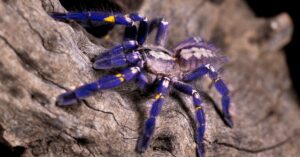
If you’ve read any of our other articles on Spider Advisor, you’ll know that we have a bit of a soft spot (alright, a huge soft spot, hush!) for this gorgeous creature.
Native to central southern India, the P. metallica can reach sizes of between 6-8 inches long. While it is young, P. metallica is less chromatic, the colouring turns to blue as it matures.
This blue is much less significant in the mature males. However, they have striking yellow markings under their legs that aids when standing in a threat posture. There are also flashes of white on their carapace and abdomen.
Under the right lighting, these truly are the most gorgeous tarantulas we’ve ever seen. Read our article dedicated to these fantasticly gorgeous creatures here.
Brazilian Jewel (Typhochlaena Seladonia)
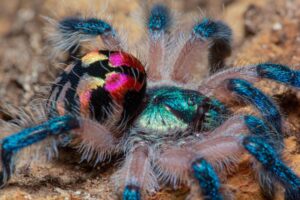
And finally, grabbing that highly coveted #1 spot is the Brazilian Jewel (T. seladonia).
As much as we love the P. metallica, this must be the most colourful and beautiful tarantula there is. Found in Brazil, these tarantulas reach sizes of 2.5 inches for females and 2 inches for males.
As a New World, they are quite docile creatures and hardly ever kick hairs. The first segment of their legs is hairy and pink, whilst the rest of the leg is a vibrant blue.
Their carapace is a bright green, and their abdomen is black with bright spots of pink, yellow and orange.
Remember, this is our personal opinion only and you may have a different one. But what do you think? Did you realise that some tarantulas could look so stunning?
